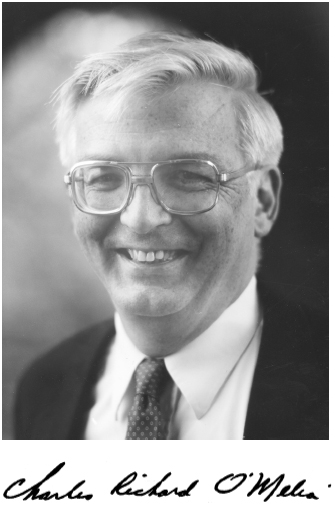
1934–2010
Elected in 1989
“For significant contributions to the theories of coagulation, flocculation, and filtration leading to improved water-treatment practices throughout the world.”
BY MENACHEM ELIMELECH
CHARLES R. O’MELIA, Abel Wolman Professor Emeritus of Geography and Environmental Engineering at Johns Hopkins University and one of the world’s leading authorities in water treatment, died on December 16, 2010, at the age of 76.
O’Melia, known to family, friends and colleagues as Charlie, was born in Manhattan, New York, on November 1, 1934. Charlie was the first child of Anne Dobbin O’Melia, an elementary school teacher, and Charles James O’Melia, an accountant. After his mother’s untimely death during the birth of his sister, Charlie moved to Brooklyn to live with his grandmother and three aunts. For much of Charlie’s life, his father worked overseas as an accountant for international construction companies.
Charlie’s fascination with New York City’s bridges and skyscrapers initially led him to study civil engineering at Manhattan College, but later he decided to focus his studies on the emerging field of environmental engineering. “It just seemed more intellectually challenging at the time,” he said in an interview with the Johns Hopkins University Gazette in 2000.
O’Melia earned his master’s degree in environmental engineering in 1956 from the University of Michigan. That same year he also married Mary Curley and began a family
that would grow to six children. He then returned to New York City for an engineering consulting job with Hazen and Sawyer Engineers. The consulting job, however, was short-lived as O’Melia decided to return to the University of Michigan to pursue his PhD in environmental engineering, which he completed in 1963.
Following his initial academic position as assistant professor at the Georgia Institute of Technology, Charlie carried out research as a postdoctoral fellow and lecturer at Harvard University, working with Professor Werner Stumm from 1964 to 1966 on the chemistry of coagulation and filtration in water treatment. His seminal work with Stumm at Harvard resulted in award-winning publications that provided new chemical insights into the mechanisms of particle removal by coagulation and filtration.
After Harvard, Charlie joined the Department of Environmental Science and Engineering at the University of North Carolina (UNC) and was promoted to full professor in 1970. At UNC, he excelled in teaching and research; in his first three years there, he won the department’s highest teaching award twice. “He held up the highest teaching standards for himself and he was his toughest critic,” said his UNC colleague and friend Don Lauria. “He would come to the classroom early to collect himself and write on the blackboard.”
In 1971 Charlie and his first doctoral student at UNC developed the first theoretical microscopic model for particle filtration and demonstrated its application. This pioneering work has since become standard textbook material and is widely used by water quality engineers to predict filter performance.
In 1980 Charlie accepted a position at Johns Hopkins University in the rejuvenated Department of Geography and Environmental Engineering. He spent nearly three decades with the department, including two terms as department chair. Under his leadership, the department significantly expanded and rose in stature. As Charlie told Johns Hopkins Engineering Magazine in 2007, when he announced his retirement: “It’s been remarkable to see the growth of environmental engineering in
the department, from almost non-existent in 1980 to a program that’s consistently ranked among the best in the country.”
Charlie was an inspiring and dedicated educator, both as a classroom lecturer and as a mentor to his graduate students. During his illustrious academic career, he mentored numerous doctoral and master’s students. His former graduate students now hold professorships at renowned institutions and senior positions in consulting firms and government. “Charlie mentored by his actions as a superb scholar, teacher, and engineer, interacting with great humility as he stressed the importance of fundamental concepts in solving environmental challenges,” said John Tobiason, professor of environmental engineering at the University of Massachusetts and a former doctoral student of O’Melia.
In recognition of his outstanding research accomplishments, Charlie received numerous awards and honors. He was elected to the National Academy of Engineering in 1989 for his seminal contributions to the theory and practice of particle removal in water treatment. In 2000 he was awarded the prestigious Athalie Richardson Irvine Clarke Prize for excellence in water science and technology. Widely respected for the caliber of his publications, Charlie received publication awards from numerous organizations, including the American Water Works Association (AWWA) and the Association of Environmental Engineering and Science Professors (AEESP). Other major awards included the American Society of Civil Engineers (ASCE) Simon W. Freese Environmental Engineering Award in 1985, the A.P. Black Research Award from AWWA in 1990, and the AEESP Founders’ Award in 1995.
Charlie’s leadership roles and service to the profession were exemplary. He served on numerous committees of the National Academies and many other organizations. In 2000 he served as chair of a National Research Council committee that examined the watershed management of New York City. His book summarizing this work, Watershed Management for Potable Water Supply: Assessing the New York City Strategy, is a masterpiece that combines knowledge from such diverse disciplines as environmental engineering, hydrology, watershed
management, ecology, microbiology, public health and epidemiology, urban planning, economics, and environmental law.
Charlie was a devoted family man. He took special pride in the accomplishments of his children and grandchildren. His love for his wife of 54 years, Mary, was inspiring. He was also humble, kind, caring, and giving. His devotion to his students and their loyalty and admiration to him in return is legendary. He will be greatly missed.
Charlie is survived by his wife, Mary, and their six children, Kathleen, Mary Margaret, Anne Marie, Charles, John, and Michael, 11 grandchildren, and a sister, Anne Frances.






